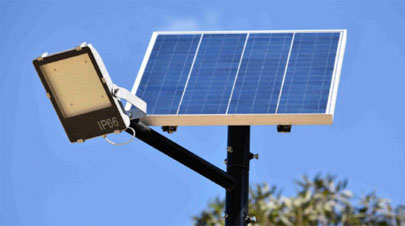
The starting point is always to test the light. This is easily done if you cover the solar panel or light sensor which fools the light into thinking it’s nighttime. This should turn the light on.
Solar lights don’t work in the daytime, they use this time to gather the energy they need for their batteries to do their job at night.
Sometimes the problem could be something quite simple, such as another source of light touching the solar panel, making it think that it isn’t night yet. In this instance, all it would take to remedy the situation is to place the panel in a position where the light source can’t reach it.
Some Easy Solutions:
- Battery Replacement – Some versions of outdoor solar lights come with rechargeable batteries. These charge in the daytime and use their energy at night. The batteries do, as a matter of course, lose this charging ability. If you notice that the light stays lit for shorter periods of time, even after being fully charged, it’s a safe assumption that this is the issue. The lifespan of a good quality battery is approximately two years and, if you’re lucky, even longer.
- The Battery Strip – Check this to ensure that the battery hasn’t come away from it. If the battery isn’t touching the terminal contacts it simply won’t charge. If you come across a battery that isn’t connected to the strip then make sure you recharge it for a few days before turning your solar light back on.
- Beware Shadows – Shadowed areas over the lights’ solar panel is a big no-no, particularly in and around midday when the sun is highest in the sky. Have a look at the solar panel every couple of months to see that it isn’t affected by too much shade at this time of day. If you’ve fitted your solar panel in the middle of summer the shadows are then at their shortest but with the change of seasons, the sun will get lower in the sky and the shadows longer.
- What is the angle of your panel – Make sure it is getting the most of the sun by changing its angle to 45°.
- Is It Facing South? – Sunrise happens in the east and sunset is west so having your panel south-facing will allow it to get sunlight from the morning right through to evening time. Your solar light will work even if not it’s facing south but it won’t be at full capacity.
- Water Ingress/Intrusion – A Solar light can sometimes have issues with water ingress but as long as it is well designed and manufactured you should be ok. Always check the IP or ingress protection rating before you buy and look for the rating which will give the unit the most protection.
- If your lucky water ingress is an issue you won’t have to deal with as many models are now made to let the water runoff them, keeping the electronics safe. If, however, water is an issue there are a number of things you can do:
- Take the cover off the light to check for moisture buildup and leave the solar light in your airing cupboard for a day or two – this will help it to dry out. When you’re putting it back together make sure the batteries are exactly where they’re supposed to be and allow the light a few days to charge before using again.
- Keep to the manufacturer’s instructions. If your unit has been correctly installed and includes a warranty with a water ingress stipulation, you should be able to just get in touch with the manufacturer, provide photographic proof of the problems you’re having for them to then replace your faulty light.
- On/Off – Does this one seem really obvious? You’d be surprised how many people forget it. There are certain solar lights that have power switches, so it’s simply a case of making sure it is in the ‘on’ position but if it does then just make sure it’s on.
- Is It Plugged In? – If your solar panel is separate from the light then it needs a solar panel cable, plugged in properly, and, in the event that there are waterproof connectors, they need to be fully secured. There are outdoor Solar lights that have the batteries in the solar panel and those which have them in the head of the light but it all boils down to this – if a battery can’t charge or there’s insufficient charge going from the battery to the lamp then it simply won’t work to its maximum capacity.
- Try mains if your panel came with a charger. Solar panels have a very specific voltage that is compatible with the circuitry and voltage of the battery. There’s a chance that the wrong mains charger could damage the circuits or charge the batteries too much, irreparably damaging your light. If you are taking the batteries out make sure they’re labeled and charge the unit using the correct charger.
- All of these have an effect on placement. Basically, if your solar light isn’t going on when it needs to, begin with the highest level of sensitivity and reduce the strength bit by bit until you’ve got the light working at the level you want.
- Charging behind A Window – Although we may be able to sit at a window and get benefits from the sun, the same rule doesn’t necessarily apply to solar panels. Outside is always the best place to position the panel, somewhere with good access to sunlight to allow it to fully charge.
- Grubby solar panel – You might sometimes find the performance of your solar panel dipping over time due to a buildup of dirt and dust. Clean it with a cloth and that should fix this issue.





